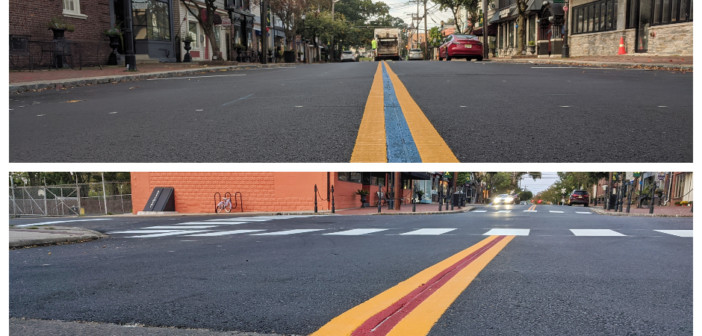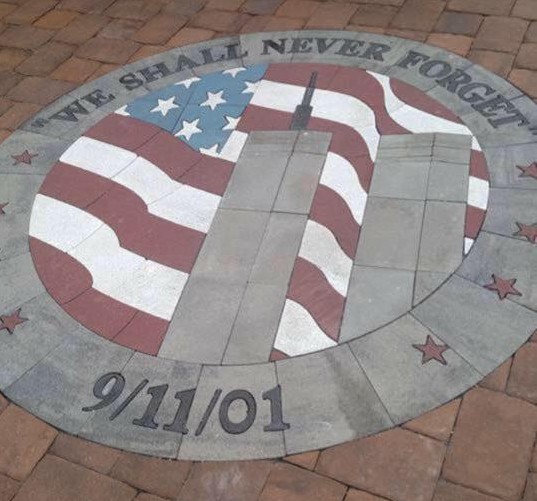In 2017, the borough added red and blue stripes to its Merchant Street median. Federal officials ruled then that they don’t comply with highway standards, but the lines have been repainted twice since.
By Matt Skoufalos | October 20, 2021
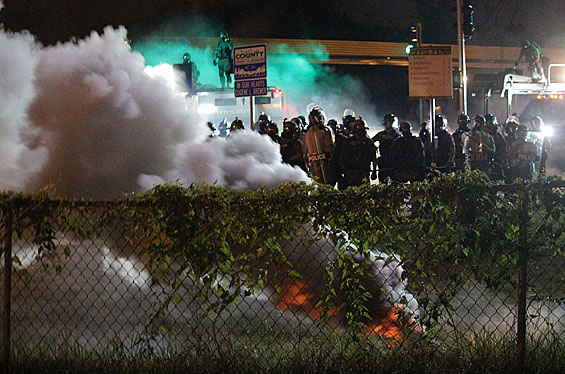
Clouds of tear gas waft over the streets of Ferguson, MO. Credit: Danny Wicentowski / Riverfront Times.
The social unrest following the police-involved death of Michael Brown in Ferguson, Missouri in August 2014 sent shockwaves throughout America that continue to reverberate (as recounted by The Associated Press here).
Brown’s death at the hands of Ferguson Police Officer Darren Wilson had been preceded a month earlier by that of Eric Garner in New York City, killed during his arrest by NYPD Officer Daniel Pantaleo, who restrained him with an illegal chokehold.
Grand juries declined to indict both Wilson and Pantaleo, in November and December 2014, respectively, which spurred further demonstrations across the country. The backlash against law enforcement that followed resulted in both additional political pressure and fatal violence against police.
In December 2014, Brooklyn native Ismaaiyl Abdullah Brinsley shot his ex-girlfriend in Owings Mills, Maryland, and then traveled by bus to the Brooklyn neighborhood of Bedford-Stuyvesant. There he killed on-duty New York City Police Officers Rafael Ramos and Wenjian Liu, completely unprovoked, and purportedly out of revenge for Brown’s and Garner’s deaths, before committing suicide.
Those closest to Brinsley told the New York Times that “he was no ardent anti-police activist, as some of his friends were… nursing no grudge against the police in Brooklyn… no stone-cold criminal” whose political philosophies would have driven him to assassinate two strangers because of their uniforms.
Yet police across the country saw Brinsley’s behavior as the natural offshoot of political pressure brought on by the Black Lives Matter movement. They decided that law enforcement needed its own political response, and formed the counter-movement, Blue Lives Matter.
Blue Lives Matter organizers sought to frame attacks against police officers as the natural consequence of anti-police bias from media reporting on the Black Lives Matter movement. Even though Black Lives Matter had been established a year earlier in response to the acquittal of George Zimmerman, a civilian, in the death of 17-year-old Trayvon Martin in his Sanford, Florida gated community, that movement gained significant and national attention after the demonstrations in Ferguson and New York.
Blue Lives Matter founders say they “were motivated by the heroic actions of Officer Darren Wilson, and many others… to create this organization in the hopes that it could prevent more officers from being hurt.” Ramos and Liu had been “ambushed and murdered by a fanatic who believed the lies of Black Lives Matter, the media, and politicians,” the organization said, and “while reporting on the murder of these heroes, the media continued to spread the false narrative of Black Lives Matter.”
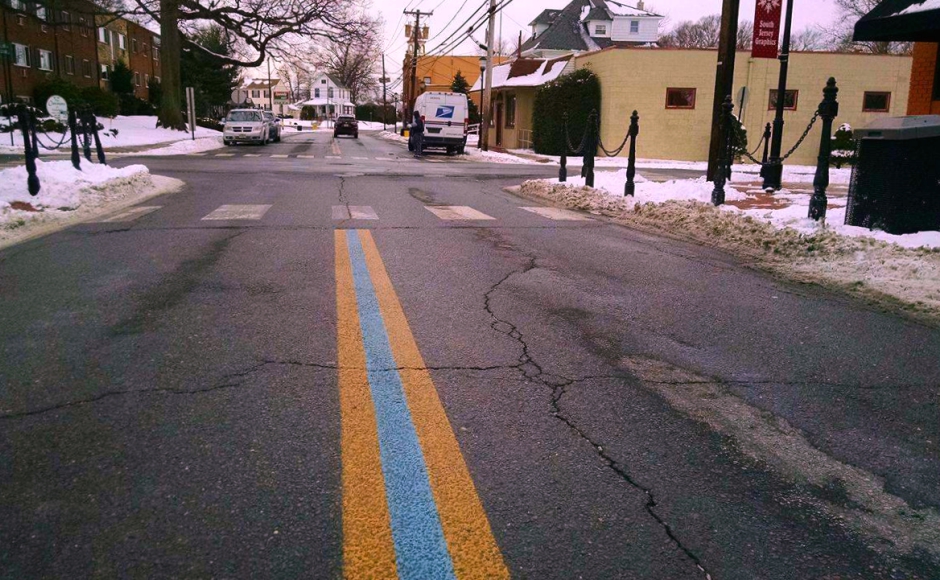
File photo: a blue line down West Merchant Street in Audubon denotes support for the local police department in 2017. Credit: Matt Skoufalos.
Shows of support
As the country grappled with the implications of these conversations about the goals and nature of policing, many local governments across South Jersey began drawing lines in the street, if not the proverbial sand.
In early 2017, communities like Cherry Hill, Haddon Heights, Oaklyn, and Audubon added a blue stripe to the double yellow roadway median in a show of support for their local police departments.
The practice had gotten so commonplace by then that Somerset County Engineer Matthew Loper wrote the Federal Highway Administration (FHWA) asking about whether the colored lines conform to the federal standard for public roadways. The response was clear: they don’t.
In a December 8, 2016 letter to Loper, FHWA Director of Transportation Operations Mark R. Kehrli referred to the Manual on Uniform Traffic Control Devices for Streets and Highways (MUTCD), which indicates that a street with two-way traffic and no passing lanes is indicated by “two parallel lines separated by a discernible space.”
The importance of keeping the space between the double yellow lines is to create a standard experience for drivers across the country. Painting over the space “can put the road user at risk due to misinterpretation of its meaning,” Kehrli wrote.
“It is therefore critical that the uniformity of pavement markings be maintained so as to present a consistent message that accommodates the expectancy of road users,” he wrote. Loper’s request for interpretation was formally codified in an official ruling from the federal agency: 3(09)-41 (I), “Markings between Double Lines.”
In his ruling, the director added that although his office “appreciate[s] the impact of expressing support for law enforcement officers… There are many appropriate and fitting ways to recognize service to the public that do not involve the modification of a traffic control device, which can put the road user at risk due to misinterpretation of its meaning.”
Kehrli’s ruling further explained that blue paint “is exclusively reserved” for parking areas that accommodate persons with disabilities. In an October 2021 e-mail to NJ Pen, the FWHA confirmed similarly that “red pavement markings are reserved for transit-only lanes,” and that “other uses of red pavement or red pavement markings are not authorized under the MUTCD.”
“There has been no change on this topic and the Official Ruling: 3(09)-41 (I), ‘Markings between Double Lines,’ still stands,” the agency wrote.
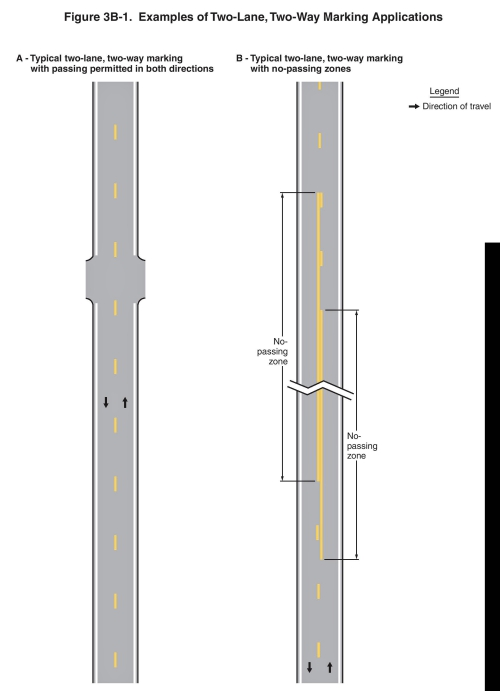
Standard highway markings according to the U.S. Manual on Uniform Traffic Control Devices. Credit: U.S. Federal Highway Administration.
Roadway lines revisited
After Kehrli’s ruling was communicated in 2017, many of the local governments that had modified their roadway striping with paint supporting their police and fire companies agreed that they would find other means to demonstrate their appreciation for their first responders.
Then-Audubon Mayor John Ward said the latex roadway paint is “going to wear away,” adding, “If it’s still there after a year, we’ll probably paint over it with black.”
But in 2020, the borough refreshed the red and blue stripes at the edges of Merchant Street without any public discussion on the matter.
Ward said it was done as a show of support for first responders during the height of the pandemic.
Then, in early October 2021, after having completed water and sewer improvements on Merchant Street, a subcontractor hired by New Jersey American Water added the blue and red lines when re-striping the road surface, crosswalks, and other pavement markings.
A spokesperson for American Water replied that both companies had been following instructions from the Audubon municipal government to restore the roadway to its former condition prior to the work being done.
When asked whether the local government had changed its mind on letting the paint fade to comply with the federal highway standard, Audubon Mayor Rob Jakubowski said “there wasn’t a conversation at all” with the contractor.
“The contractor was tasked with [restoring] what was previously there,” Jakubowski said.
“We support our local police,” the mayor said. “That’s what that line’s for. Our police are of high character, and they do so much more for us than we will ever know. ”
Jakubowski said he doesn’t believe the roadway striping reflects official support from the local government for the national Blue Lives Matter movement, nor any stance on the social dynamics of policing.
“Blue Lives Matter is not, in my opinion, a response to Black Lives Matter,” Jakubowski said. “They’re two completely independent things. Black lives do matter, and we need to be cognizant of what that means in this country.
“None of us supports a bad cop in Minnesota, Wisconsin, New York, Philly,” the mayor said. “We don’t support bad cops anywhere. We want our men and women in blue in Audubon to see that we support them.”
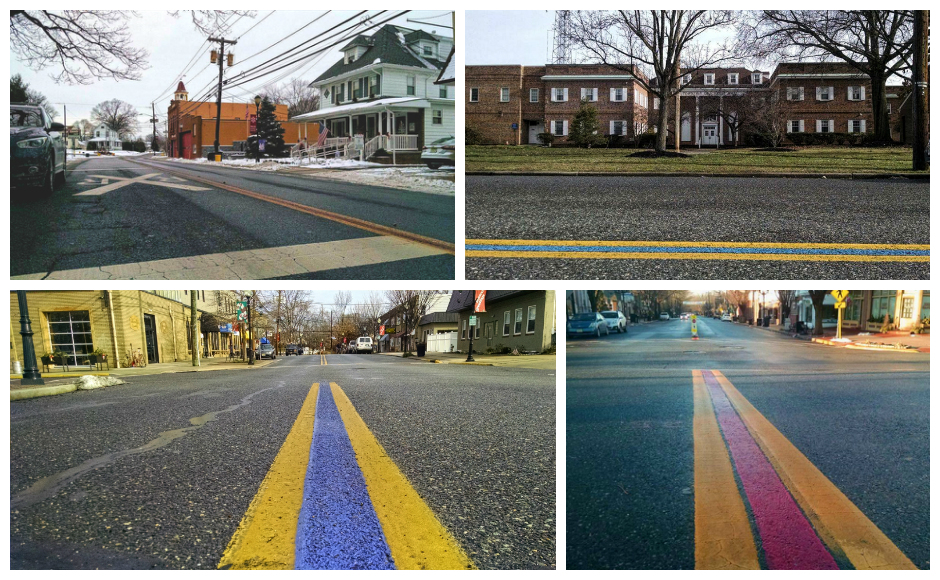
2017 file photo: lines of support for first responders painted in the roadways of South Jersey towns do not conform to federal roadway standards. Credit: Matt Skoufalos.
‘It’s not a very good idea’
The question of whether using the public roadways to demonstrate that support is appropriate remains one on which there is little consensus.
In addition to violating federal highway statutes, the contradiction persists of how and why it’s been done.
In short, what is the value of demonstrating support for law enforcement by flouting the rules they’re tasked with upholding?
Sandy Malone, Managing Editor of The Police Tribune, a law-enforcement-minded publication begun as the official online presence of the Blue Lives Matter movement, said that “most police officers aren’t fans of it.”
“Sure, they appreciate the support, but the colored lines—or anything that changes the standard, approved road markings—can be confusing, and can cause accidents, and that’s the last thing they want to see happen,” Malone said.
“Speaking as the wife of a retired police captain, my husband hates it, and thinks it’s dangerous,” she said.
“Given the general attitude toward law enforcement in recent years, he appreciates any show of support that he sees. That’s just one that isn’t a very good idea.”
Neither does Audubon Fire Chief Patrick Slemmer believe that the roadway striping is the best way for the local government to demonstrate its support of his department, which is tasked with enforcing building codes in the name of fire safety.
“I thought it was nice when they did it because it was during the time of Ferguson and Dallas,” Slemmer said. “I don’t believe it has to be there. If it violates traffic law, I would never want my department to have to go against [it].
“When we find that out, we probably should stop this activity, set the example,” Slemmer said. “It’s a symbolic thing, but it’s not the right thing because it involves traffic, it involves the law, and it involves safety.”
Even without the roadway striping, Slemmer believes that Audubon “shows tremendous support” for all its civil employees, including police, fire, and public works staff.
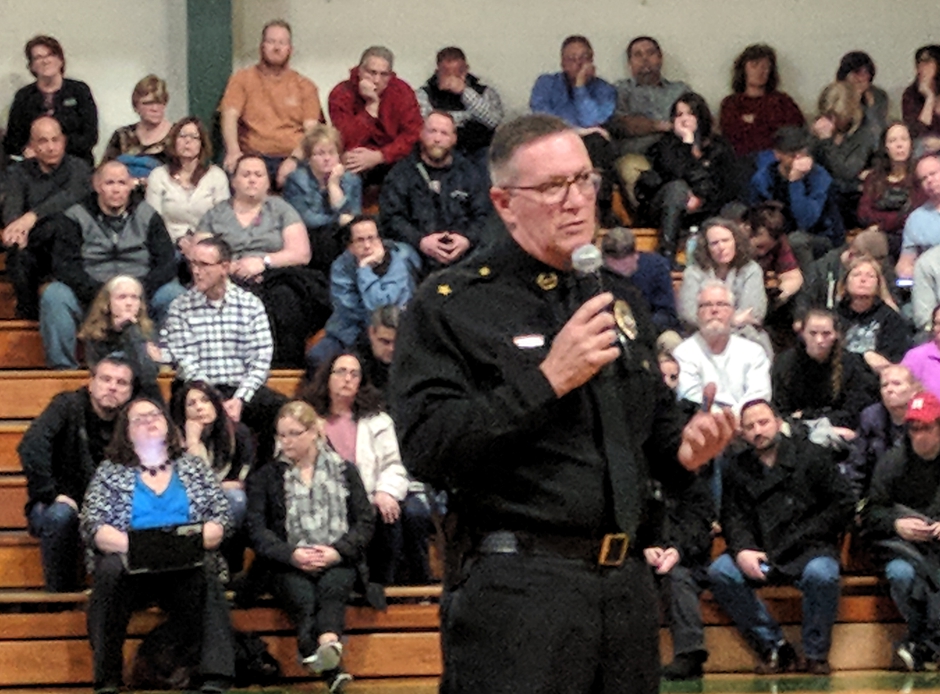
File photo: Audubon Police Chief Thomas Tassi speaking to Audubon School District families in 2018. Credit: Matt Skoufalos.
However, his perspective isn’t shared by Audubon Police Chief Thomas Tassi, who said that the borough government’s demonstration of support for its first responders “overshadows that minor speck in [federal] code.”
“I liked it when they [painted the line] initially,” Tassi said.
“I like that it’s nice and bright and clean now,” he said.
“We’re honored that that’s there.”
Tassi’s interpretation of the federal ruling is that “the emphasis is on the solid double line,” and that adding red or blue to the middle won’t confuse drivers.
“I really don’t see it that way,” he said. “I don’t think there’s enough of a safety concern. I could make the argument that we don’t even need the [double yellow] line on that street.”
The chief summed up the political climate around policing as “a very difficult time for law enforcement,” and said he is “very thankful for the special relationship we have in a small town.
“One of the things I’m disappointed in is there’s been some incidents in this country that don’t reflect the majority of the people who serve their communities every day,” Tassi said. “I think our police department historically has done a good job.”
Symbolic gestures and meaningful conversations
The problem with symbolic gestures, said Christopher E. Smith, a professor of criminal justice at Michigan State University who’s done scholarship on the Blue Lives Matter and Black Lives Matter movements, is whether they communicate their intended messages effectively.
If a blue or red stripe is meant to confer feelings of reflection and contemplation about the sacrifices and commitments of first responders, does roadway paint really present an opportunity to do so?
“It seems strange to me to do it in this way, when, for example, we want drivers to have their eyes up, and be scanning and looking for vehicles and pedestrians,” Smith said.
“Given the purposes symbols are supposed to have, I think that is probably lost, if not counterproductive, to think that this kind of symbol would really have that objective of pausing, reflecting, honoring, when it’s done in that way,” he said.
“It doesn’t make a lot of sense the same way a plaque in a park might make sense,” Smith. “It’s a short-term reaction to something that’s going on in the world.”
The historical fact of Blue Lives Matter arising in opposition to the Black Lives Matter movement is “problematic,” Smith said, because it represents a reaction to feeling attacked rather than a mechanism to address the concerns that both law enforcement and the public they police share about their relationship.
“The use of Blue Lives Matter has been used too often as a reflexive way to refute Black Lives Matter rather than to stop and think about what’s the substance that underlies this,” Smith said.
“Wouldn’t substantive meaning be more important than reactive symbolism?” he asked. “What would it mean in terms of substantive changes to help officers reduce the dangers in the jobs they face? It strikes me as more important than symbols.”
Fighting over which social campaign truly represents the vulnerable and the victimized in the relationship between police and the communities that employ them shouts down conversations about policy changes that really help police and civilians, Smith said.

Christopher E Smith, Professor with the School of Criminal Justice at Michigan State University. Credit: MSU.
Discussing things like sensible gun control, expanded access to mental and behavioral health services, and resources to take social work out of the hands of police would all be more substantive without the symbolic rhetoric, he argued.
Smith also believes the problem of “occupational umbrage,” a collective, innate, job-related defensiveness born out of the climate of identity politics, is muddying the waters.
The “risk of being thin-skinned about hearing criticisms about someone else who shares your occupation” can overshadow important conversations about the best way to do the job, he said.
Just as individual officers may feel hardened by universal critiques of police, nobody in any line of work wants to be held as a stand-in for everything that’s wrong with it.
“If you reflexively say, ‘We’re going to defend police in Ferguson, Missouri even though we don’t really know how they operate, you’re saying, ‘We don’t want to listen to people who’ve had improper interactions with police officers, who are walking around on eggshells about how they’ve been treated,’” Smith said.
Even if a community has nothing but overwhelming support for local law enforcement, customers who see a thin blue line on a public roadway in a shopping district—especially one which is home to Black-owned businesses—may not interpret the symbol the same way. Given the variability in interpreting such symbols, they don’t have to spark political demonstrations to inspire feelings of deep discomfort.
“I think there’s a risk of people genuinely having that perception,” Smith said. “If you don’t think through symbols, and they’re reactive, you can’t understand the messages that are being received by it.
“The problematic things may not be visible to you and me,” he said. “We have things that go on in the United States where people use race as a clue to trigger their fears and hostility. It triggers suspicion that leads to action that does not follow the law.
“This leads to a lot of wariness, if not more thinking about, ‘What are the authorities telling me? Do they want to listen? Do they want to learn?’” Smith said.
Please support NJ Pen with a subscription. Get e-mails, follow us on Facebook, Twitter, and Instagram, or try our Direct Dispatch text alerts.

